To capture eco-friendly buildings with drone photography, you'll need a high-resolution camera, gimbal stabilizer, and safety features like obstacle avoidance. Plan your flight path to highlight key sustainable elements such as solar panels, green roofs, and rainwater systems. Consider lighting conditions and weather patterns for ideal shots. Frame your images to showcase the building's integration with its environment and energy-efficient design. Use various angles and altitudes to capture diverse perspectives. In post-processing, enhance colors and apply selective sharpening to emphasize sustainable features. Remember to obtain necessary permits and respect privacy regulations. Exploring these techniques will elevate your eco-architecture photography to new heights.
Selecting the Right Drone Equipment
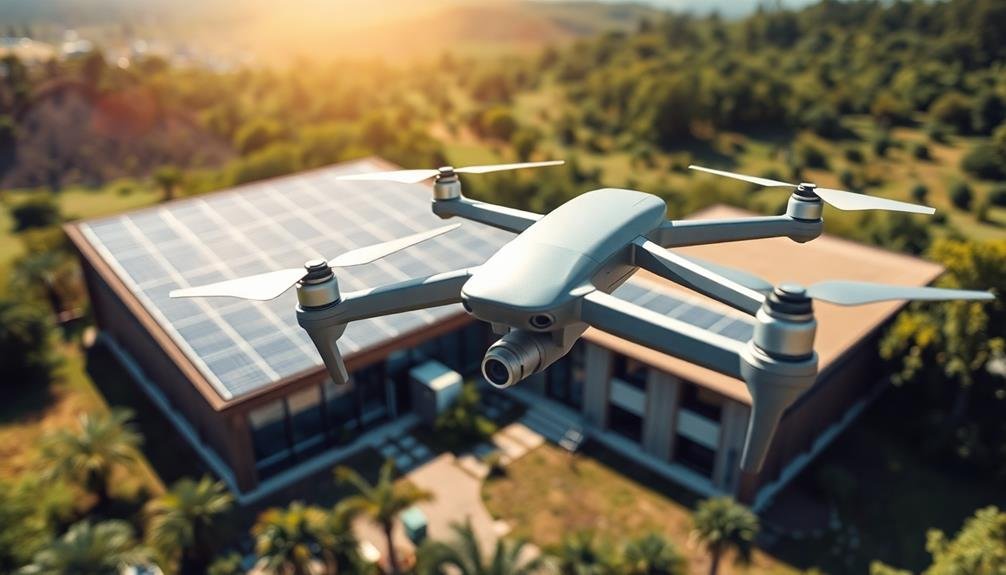
Choosing the right drone equipment is vital for capturing stunning aerial shots of eco-friendly buildings.
You'll want to start with a drone that offers high-resolution camera capabilities, ideally 4K or higher. Look for models with adjustable aperture and ISO settings to handle varying light conditions often encountered when photographing buildings.
Consider drones with obstacle avoidance technology to safely navigate around structures. Opt for a model with a gimbal stabilizer to guarantee smooth, professional-looking footage.
Battery life is important, so select a drone that can fly for at least 20-30 minutes on a single charge.
Don't forget about accessories. Invest in spare batteries, propellers, and memory cards. A tablet or smartphone with a large screen will help you see details clearly while framing your shots. ND filters can be useful for controlling exposure in bright conditions.
Lastly, choose a drone that's easy to transport. Foldable models are ideal for moving between locations.
Planning Your Eco-Building Photography Flight

Before you take flight, you'll need to scout ideal paths around the eco-friendly building, ensuring you capture all key sustainable features.
Identify green roofs, solar panels, rainwater harvesting systems, and other eco-elements that showcase the building's environmental design.
Don't forget to take into account weather patterns and lighting conditions to maximize the quality of your aerial shots.
Scouting Optimal Flight Paths
When it comes to capturing stunning aerial shots of eco-friendly buildings, careful flight path planning is essential. Begin by studying satellite imagery and maps of the area to identify potential obstacles and points of interest. Look for unique architectural features, solar panels, green roofs, or sustainable landscaping that you'll want to highlight in your shots.
Next, visit the location in person to assess lighting conditions at different times of day. Note how shadows fall across the building and surrounding landscape. This will help you determine the best time for your flight to capture ideal lighting and minimize harsh shadows.
Consider the building's orientation and the sun's position to plan your flight paths. You'll want to capture the structure from various angles, so map out several routes that showcase different aspects of the eco-friendly features.
Don't forget to account for wind direction and speed, as these factors can affect your drone's stability and battery life.
Identifying Key Eco-Features
With your flight paths mapped out, it's time to pinpoint the eco-friendly features you'll want to showcase in your drone photography. Start by researching the building's green credentials and identifying its most innovative sustainable elements. Look for solar panels, green roofs, rainwater harvesting systems, and energy-efficient windows.
Pay attention to the building's orientation and how it maximizes natural light. You'll want to capture these features during golden hour for the best lighting.
Don't forget about the surrounding landscape – sustainable buildings often incorporate native plants and water-conserving gardens.
Consider the building's shape and how it might contribute to energy efficiency. Unusual angles or curved surfaces could make for striking aerial shots. Look for any visible smart technology, such as automated shading systems or wind turbines.
If possible, consult with the building's architects or sustainability experts to understand less obvious eco-features. They might point out innovative insulation techniques or recycled building materials that you can highlight through close-up shots.
Remember to capture the building's context, showing how it integrates with its environment and contributes to local sustainability efforts.
Your drone photography should tell the complete story of the building's eco-friendly design and impact.
Weather and Lighting Considerations
Weather and lighting play essential roles in capturing stunning drone photos of eco-friendly buildings. You'll want to plan your flight during the golden hour, just after sunrise or before sunset, when the soft, warm light enhances the building's eco-features.
Overcast days can also provide diffused light that minimizes harsh shadows and highlights sustainable materials.
Consider the building's orientation and how sunlight interacts with its eco-elements throughout the day. Solar panels, for instance, might be best captured when reflecting the sun's rays. Wind turbines are more visually striking when there's a gentle breeze to spin their blades.
Be mindful of weather conditions that could affect your drone's performance. Strong winds can destabilize your aircraft and impact image quality. Rain or high humidity might damage your equipment and create unwanted reflections.
Check the forecast and aim for clear, calm days.
Seasonal changes can also influence your shots. Deciduous trees surrounding the building will look different in summer versus winter, potentially revealing or obscuring eco-features.
Plan multiple shoots throughout the year to showcase the building's adaptability to changing environmental conditions.
Capturing Sustainable Design Elements
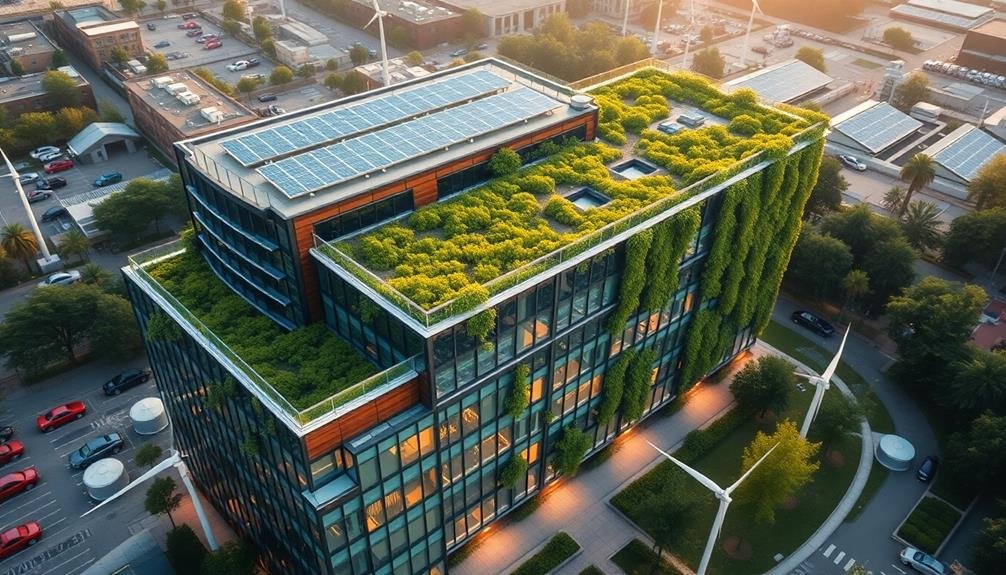
As you focus your drone's camera on eco-friendly buildings, it's vital to highlight their sustainable design elements. Look for solar panels, green roofs, and rainwater harvesting systems, which are often prominent features. Capture these elements from various angles to showcase their integration into the overall design.
Pay attention to the building's orientation and natural shading. Frame shots that demonstrate how the structure maximizes natural light and minimizes heat gain. Zoom in on energy-efficient windows and innovative insulation materials when visible.
Don't overlook landscaping elements like native plants, permeable paving, and bioswales. These features play significant roles in sustainable design and can create visually appealing compositions.
For buildings with wind turbines or geothermal systems, try to capture both the technology and its surrounding context. This helps viewers understand how the building interacts with its environment.
Aerial Perspectives of Green Roofs
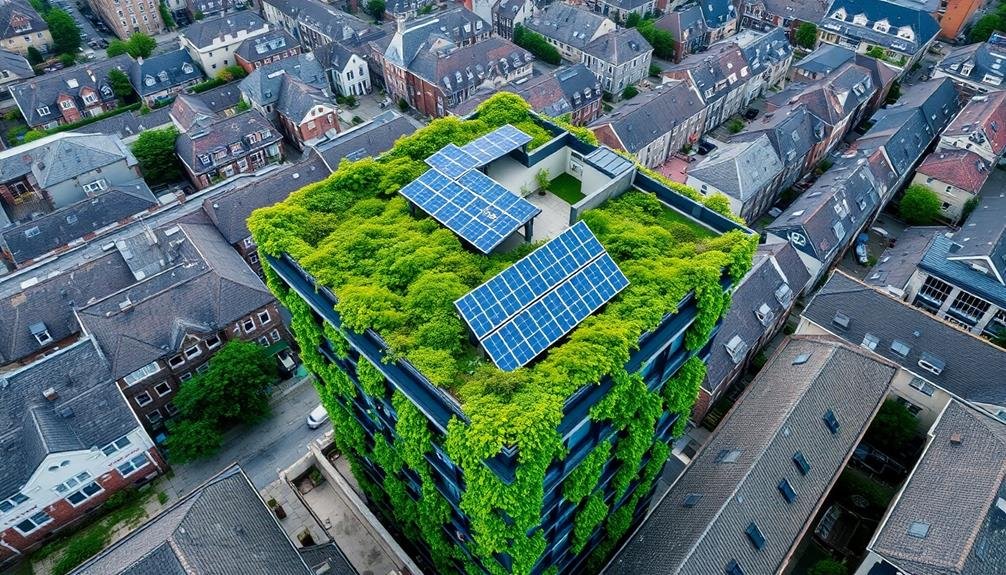
When capturing green roofs from above, you'll want to focus on three key elements.
Start by framing the vibrant patterns created by rooftop vegetation, which showcase the building's commitment to biodiversity.
Next, highlight the geometric layouts of solar panels, demonstrating the structure's renewable energy capabilities.
And don't forget to capture any visible rainwater collection systems that contribute to water conservation efforts.
Capturing Rooftop Vegetation Patterns
Three key elements make aerial shots of green roofs truly mesmerizing: patterns, textures, and contrasts. When capturing rooftop vegetation patterns, you'll want to focus on these aspects to create visually striking images. Look for geometric shapes formed by different plant species, pathways, or architectural features.
Pay attention to the varying textures created by different types of vegetation, from smooth grass to rough succulents.
To highlight the patterns effectively, consider the following:
- Time your shoot during the golden hour for warm, soft lighting that enhances colors and shadows.
- Experiment with different altitudes to find the perfect balance between detail and overall composition.
- Use symmetry and leading lines to guide the viewer's eye across the image.
- Incorporate contrasting elements, such as water features or solar panels, to add visual interest.
As you frame your shots, adjust your drone's camera settings to guarantee peak exposure and sharpness. Use a higher shutter speed to minimize motion blur, and consider bracketing your exposures to capture the full dynamic range of the scene.
Highlighting Solar Panel Layouts
How can you capture the sleek geometry of solar panel arrays from above? Start by flying your drone on a clear, sunny day to maximize contrast and minimize shadows. Position your drone directly overhead for a bird's-eye view that showcases the entire layout. Experiment with different altitudes to find the sweet spot that balances detail and overall composition.
Use grid lines in your camera's viewfinder to align the solar panels symmetrically within the frame. This will enhance the visual impact of their geometric patterns. Try shooting in RAW format to preserve more detail for post-processing. Adjust your camera settings to slightly underexpose the image, preventing the reflective panels from appearing washed out.
For added interest, capture the panels at different times of day to showcase how sunlight interacts with their surfaces. Early morning or late afternoon light can create striking long shadows that emphasize the panels' texture.
Don't forget to include surrounding context, such as rooftop structures or nearby greenery, to provide scale and contrast. Finally, consider using a wide-angle lens to encompass larger arrays, or a telephoto lens to zoom in on interesting panel configurations or connection points.
Showcasing Rainwater Collection Systems
In light of the growing importance of sustainable water management, aerial drone photography offers a unique perspective on rainwater collection systems and green roofs. You'll be able to capture the intricate network of gutters, downspouts, and storage tanks that make up these innovative systems.
From above, you can showcase the full scale and integration of these features within the building's design.
When photographing green roofs, focus on their lush vegetation and diverse plant life. You'll want to highlight how these living roofs contribute to both rainwater management and building insulation.
Capture the contrast between the natural elements and surrounding urban landscape to emphasize the eco-friendly nature of the building.
To create emotional impact with your drone photography of rainwater systems and green roofs:
- Frame shots that juxtapose the vibrant green against stark cityscapes
- Capture the flow of water through the collection system during rainfall
- Showcase the transformation of barren rooftops into thriving ecosystems
- Highlight the harmonious integration of nature and architecture
Showcasing Energy-Efficient Building Features

Capturing energy-efficient features of eco-friendly buildings through drone photography can be both challenging and rewarding. To showcase these elements effectively, you'll need to plan your shots carefully and use your drone's capabilities to their fullest.
Start by focusing on solar panels, which are often the most visible energy-efficient feature. Fly your drone at different angles to capture the full expanse of rooftop arrays, highlighting their integration with the building's design.
For windows with special coatings or double-pane glass, try to capture them at angles that show reflections or transparency differences compared to standard windows.
Don't forget about external shading devices like louvers or overhangs. These architectural elements can be beautifully highlighted from aerial perspectives, especially during golden hour when shadows are long.
If the building has a green roof or living wall, use your drone to showcase how these features blend with the surrounding environment.
For buildings with wind turbines, fly your drone to capture them in action, emphasizing their scale and integration with the structure.
Post-Processing for Environmental Highlights
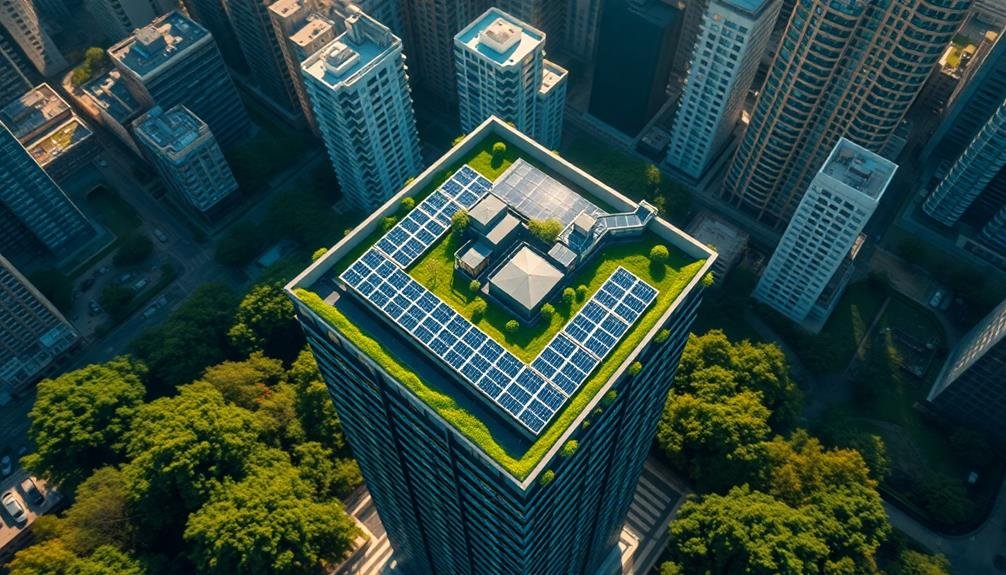
Once you've wrapped up your drone shoot, it's time to plunge into post-processing to really make those environmental features pop. Focus on enhancing elements that showcase the building's eco-friendly aspects.
Adjust colors to highlight solar panels, green roofs, or energy-efficient windows. Use selective sharpening to draw attention to sustainable materials or innovative architectural designs.
Don't forget to balance your edits. While you want to emphasize eco-friendly features, maintain the overall integrity of the image. Subtle adjustments often yield the most impactful results.
Consider using split-toning techniques to create a cohesive look that emphasizes the building's harmony with its surroundings.
To evoke emotion in your audience, consider these post-processing goals:
- Accentuate the building's integration with nature
- Highlight the contrast between sustainable design and traditional architecture
- Amplify the sense of innovation and forward-thinking
- Convey a feeling of hope for a greener future
Ethical Considerations in Drone Photography
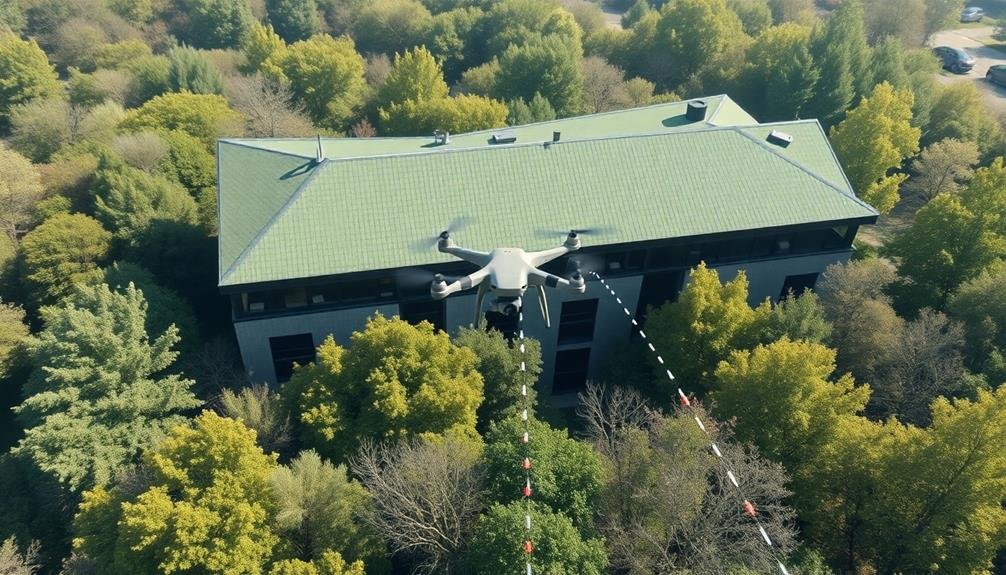
While drone photography offers exciting possibilities for capturing eco-friendly buildings, it's crucial to navigate the ethical landscape with care. You'll need to take into account privacy concerns, environmental impact, and legal regulations. Always obtain necessary permits and permissions before flying, and respect no-fly zones and private property boundaries.
Be mindful of wildlife and ecosystems when operating your drone. Avoid disturbing nesting birds or sensitive habitats. Use quiet, energy-efficient drones when possible to minimize noise pollution and reduce your carbon footprint.
Here's a quick reference guide for ethical drone photography:
| Do | Don't |
|---|---|
| Obtain necessary permits | Fly in restricted areas |
| Respect privacy and property | Disturb wildlife or ecosystems |
| Use energy-efficient equipment | Ignore local regulations |
| Share educational content | Compromise safety for a shot |
Frequently Asked Questions
How Do Weather Conditions Affect Drone Photography of Eco-Friendly Buildings?
Weather greatly impacts your drone photography of eco-friendly buildings. You'll face challenges with wind, rain, and extreme temperatures. Sunlight can create glare or shadows. You'll need to adapt your settings and timing for ideal results.
What Licenses or Permits Are Required for Commercial Drone Photography?
You'll need a Remote Pilot Certificate from the FAA for commercial drone photography. Don't forget to register your drone and check local regulations. Some areas may require additional permits or insurance for commercial operations.
Can Drones Capture Thermal Imaging to Showcase Building Energy Efficiency?
Yes, you can equip drones with thermal cameras to capture energy efficiency. They'll detect heat loss, insulation issues, and HVAC problems. You'll get a visual representation of a building's thermal performance, highlighting areas needing improvement.
How to Collaborate With Architects and Building Owners for Access?
You'll need to reach out early to architects and building owners. Explain your project's goals and benefits. Offer to share the final images. Be prepared to address safety concerns and provide necessary certifications for drone operations.
What Are the Best Times of Day for Eco-Building Drone Photography?
For eco-building drone photography, you'll get the best results during golden hour, just after sunrise or before sunset. You can also capture stunning shots at midday to highlight solar panels and green roofs in full sunlight.
In Summary
You've now got the tools to capture stunning aerial images of eco-friendly buildings. Remember to choose your equipment wisely, plan your flights carefully, and focus on sustainable design elements. Highlight green roofs and energy-efficient features from unique perspectives. In post-processing, emphasize environmental aspects. Always consider ethical implications and respect privacy. With these skills, you'll create compelling visuals that showcase the beauty and importance of sustainable architecture. Keep practicing and innovating!

As educators and advocates for responsible drone use, we’re committed to sharing our knowledge and expertise with aspiring aerial photographers.




Leave a Reply